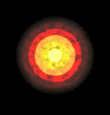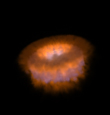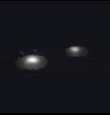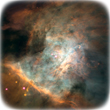The Case of the Massive Forming Star
Theories for massive star formation
Most astronomers agree that the Sun, like many smaller stars, formed after cloud material collapsed to form a protostar, under the influence of gravity. The material was funnelled onto the protostar from an equatorial disk, accompanied by outflowing jets of excess material that could not quite make it to the protostellar surface. However, massive stars are so large and so bright, it’s possible that they form in a different way. The brighter the star, the more resistance infalling gas meets - the effect of "radiation pressure." The impact could change everything, but no one is sure. Scientists have put forward a number of different theories to explain how they form.










